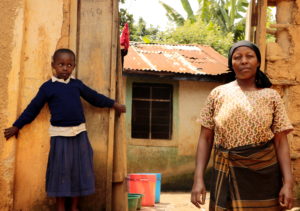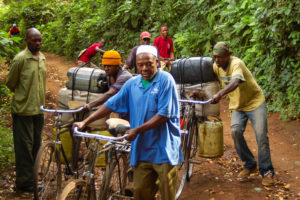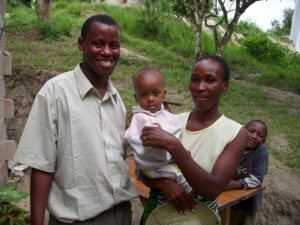
Including the voices of both male and female farmers in the larger decision-making process at a national level sounds logical, but how can it be done in practice?
“Usually these farmers don’t have a chance to talk directly to the large companies,” said Principal Investigator Emily Gallagher of the Center for International Forestry Research (CIFOR). “It is for this reason that we have decided to include documentary filming and community screening as an essential part of the research process, to give these farmers a voice.”
A project led by CIFOR, under a cross-CGIAR Research Program collaboration with the CGIAR Research Program on Forests, Trees and Agroforestry (FTA), the CGIAR Research Program on Policies, Institutions, and Markets (PIM) and the CGIAR Research Program on Water, Land and Ecosystems (WLE), uses an innovative methodology including documentary filming, community screening and local and national level workshops to do just that.
Visualization of research
Gallagher and her team are currently undertaking field visits, with a focus on sugarcane farmers, done in collaboration with enumerators and partners from the University of Dar es Salaam.
“What I am really interested in is the visual communication aspect and the visualization of the research. This is what we are trying to reach through the use of the documentary film. For now, we have interviewed and filmed three people per community [six in total for the sugarcane farmers]. Two of them are outgrowers and one of them is a non-outgrower. Then, I want to use the issues that come out of the filming workshop as a guide to structure the dialogue and capture the communities, using a dialogical process with a strong facilitation, together with the investors,” she explained.
This involved exercises with various communities, including both men and women, and outgrowers and non-outgrowers, to understand what guided their decisions to say yes or no to becoming members of sugarcane associations.

“Another approach we take is using scenarios. We try to understand what, for example, an increase or decrease of the sugar price would mean for them: Would they leave or join associations? What would this mean for the adjoining forest? What would it mean for water scarcity or water quality?” Gallagher added.
The project then went a step further, by filming the interviews and creating a documentary, along with other footage. This film was screened at the beginning of September to two communities. The screenings were open to the whole community, and were also attended by the researchers and an invited district officer. The following day a workshop was held with village representatives. Furthermore, the movie was shared in the same week with the investor.
“We engage them all together in a local workshop, in which the video will serve as a means of facilitation. Here we will film their feedback, their reactions, their ideas and any other topics that might surge,” she said.
After this, the team will make a second version of the movie, which will be shown during a national workshop, to which national decision-makers will be invited.
“This way, again, the video will serve as a way to show the voices from the field, as a guide in the facilitation of the national workshop and as a tool to gain empathy and understanding of national decision-makers [about] what it is like to be a smallholder sugarcane farmer.”
Find out more: Gendered dimensions of large-scale and smallholder-inclusive agricultural investments in Tanzania
Gendered or generational restricted access?
In regards to the gender approach in the project, the results have been interesting thus far: In the community of Kitete, farmers tend to have very little land and therefore the whole household works together on the same plot. Therefore, the division between food crops and cash crops is not so clear, nor is the gender division of tasks.

Female farmers who were not part of the association were asked whether they felt there was gender-restricted access. However, they said there was more of a youth restriction: Most young farmers do not have land because they have not inherited any. This land scarcity is also the cause of a lot of internal household conflicts in which various children fight for a very small piece of land, and why only very few farmers can buy land, because no one is selling it.
The only valid reason, as the interviewed farmers mentioned, for moving away from sugarcane production would be if prices dropped and thus the return on investment did not make production worth it anymore.
Field visits to suspicious sugarcane farmers
But it has not been as easy as it sounds, according to Gallagher. As always, field visits begin with traditional village introductions, done together with government officials based in the village, the village chairperson and subvillage leaders, partners from the University of Dar es Salaam, and later with a professional filmmaker. Reactions to their presence and the documentary filmmaking proposal have been quite diverse.
In the first village, a longer follow-up explanation was needed to clarify that CIFOR’s intention was not to convince farmers to join big cooperatives, as they had seen done in the past, but purely to understand the context and reasons for day-to-day decisions that the sugarcane farmers make.
“Basically, the context in which we are working here in Tanzania is one of quite some suspicion and mistrust. Farmers have no means to talk directly to large agribusiness and a lot of misinformation is going around. I think if companies had more open communication pathways about their management practices and market strategies, much of the distrust would dissipate,” said Gallagher.
It can be said that the sugarcane market works through associations. “Overall, outside of the associations, there is no market for sugarcane. So unless it is a food crop, farmers need to somehow become a member of an association to sell their product. However, it seems that farmers are trusting the associations more than the government-backed cooperatives, which they have called corrupt and misguiding,” Gallagher added.
Gallagher will be in the field in coming months, shifting her focus toward rice and tea farmers in Tanzania. Gender dimensions in these communities are expected to bring different outcomes.
By Manon Koningstein, FTA Gender Integration Team.
This project is part of a larger study to examine the local impacts of commercialization across the Southern Agricultural Growth Corridor of Tanzania (SAGCOT). The initiative aims to improve national food security, reduce poverty and support climate-resilient livelihoods through sustainable agricultural growth. In practice, SAGCOT will grow through public-private partnerships to finance agricultural infrastructure, value chain development and various smallholder outgrower schemes in Tanzania.
The government of Tanzania, private investors and civil society organizations have outlined a commitment to social inclusion and climate-smart development through the SAGCOT Investment Blueprint (2011) and the Green Growth Investment Framework (2013).
However, some consider that these instrumental investment frameworks have overlooked the ways in which they could also serve as an example of the pathways that safeguard women’s access and household food security, while at the same time promoting gender-inclusive green growth.
Thus the next new phase was entered the research process. This phase, led by Emily Gallagher, aims to contribute to the dialogue by analyzing the social, economic and institutional factors that affect gendered access to these agro-investments and to propose pathways for the government of Tanzania’s socially inclusive vision for SAGCOT.
It does so through a set of methods and communication instruments for documenting the gender baseline in the initial stages of SAGCOT development. The gender baseline measures the relative level of women’s participation in SACGOT outgrower schemes and how this impacts household food security and gendered distribution of benefits. Furthermore, it aims to provide an opportunity to operationalize the government of Tanzania’s gender inclusive policies through innovative practice.
This work forms part of the CGIAR Research Program on Forests, Trees and Agroforestry. We would like to thank all donors who supported this work through their contributions to the CGIAR Fund.











